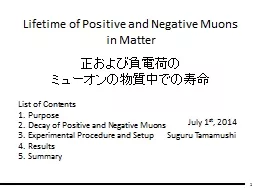PPT-正 および
Author : olivia-moreira | Published Date : 2016-05-23
負電荷の ミューオンの物質中での寿命 July 1 st 2014 Suguru Tamamushi List of Contents Purpose Decay of Positive and Negative Muons Experimental
Presentation Embed Code
Download Presentation
Download Presentation The PPT/PDF document "正 および" is the property of its rightful owner. Permission is granted to download and print the materials on this website for personal, non-commercial use only, and to display it on your personal computer provided you do not modify the materials and that you retain all copyright notices contained in the materials. By downloading content from our website, you accept the terms of this agreement.
正 および: Transcript
負電荷の ミューオンの物質中での寿命 July 1 st 2014 Suguru Tamamushi List of Contents Purpose Decay of Positive and Negative Muons Experimental Procedure and Setup Results.
Download Document
Here is the link to download the presentation.
"正 および"The content belongs to its owner. You may download and print it for personal use, without modification, and keep all copyright notices. By downloading, you agree to these terms.
Related Documents

